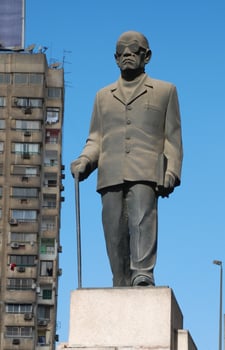Who is Naguib Mahfouz, and why should you read his works of fiction? Mahfouz was born in Cairo, Egypt in 1911, and he wrote ten novels within a span of just over a decade. However, the reason that most of us know Mahfouz’s work has to do with a series of works he wrote in the late 1950s which ultimately led to him winning the Nobel Prize in Literature in 1988. In 1957, the “Cairo Trilogy” appeared, which included three texts: Between-the-Palaces, Palace of Longing, and Sugarhouse. According to the Nobel Prize committee, these narratives “made him famous throughout the Arab world as a depictor of traditional urban life.” In the years that followed, Mahfouz’s writing became more political, critiquing systems of governance in Egypt and intimating a deep-rooted need for freedom of expression. By the time he was awarded the Nobel Prize, he had written thirty novels and over one hundred short stories. When we think about Mahfouz today, what should we remember?
Depictions of Modern Egypt in Arabic Novels
 In short, many scholars connect the rise of the Arabic novel to the literary production of Mahfouz. And while his work has been described as depicting modern life in Egypt at mid-century, his language does much more than that. To be sure, as a writer concerned deeply with Egyptian society and politics in the country, Mahfouz’s novels explore Egypt’s national memory in relation to its contemporary politics as it focuses on modern family life. Are you interested in reading some of the “Cairo Trilogy” for yourself and learning about the texts that won Mahfouz the Nobel Prize? Here’s a teaser for you from the opening pages of the first book in the trilogy, Between-the-Palaces:
In short, many scholars connect the rise of the Arabic novel to the literary production of Mahfouz. And while his work has been described as depicting modern life in Egypt at mid-century, his language does much more than that. To be sure, as a writer concerned deeply with Egyptian society and politics in the country, Mahfouz’s novels explore Egypt’s national memory in relation to its contemporary politics as it focuses on modern family life. Are you interested in reading some of the “Cairo Trilogy” for yourself and learning about the texts that won Mahfouz the Nobel Prize? Here’s a teaser for you from the opening pages of the first book in the trilogy, Between-the-Palaces:
“She woke at midnight. She always woke up then without having to rely on an alarm clock. A wish that had taken root in her awoke her with great accuracy. For a few moments she was not sure she was awake. Images from her dreams and perceptions mixed together in her mind. She was troubled by anxiety before opening her eyes, afraid sleep had deceived her. Shaking her head gently, she gazed at the total darkness of the room. There was no clue by which to judge the time . . . . She had no evidence to rely on except her intuition, like a conscious clock hand, and the silence encompassing the house, which revealed that her husband had not yet rapped at the door and that the tip of his stick had not yet struck against the steps of the staircase.”
Mahfouz’s Significance as an Arabic-Language Writer
 As we mentioned above, Mahfouz became known for the novels contained within his “Cairo Trilogy,” published originally in the late 1950s. When Mahfouz came on the literary scene, however, Egyptian novels were not the norm. Indeed, as Sabry Hafez explains in her introduction to the Everyman’s Library edition from 2001, “[n]ovels were unknown in Arabic literature before the twentieth century . . . That did not prevent it from firing the imagination of the young Mahfouz and inspiring him to become the new Shahrazad of Arabic narrative. The thirty years between the birth of the Arabic novel and Mahfouz’s first work can be seen retrospectively as preparing the ground for the arrival of the master par excellence of this genre in Arabic literature.”
As we mentioned above, Mahfouz became known for the novels contained within his “Cairo Trilogy,” published originally in the late 1950s. When Mahfouz came on the literary scene, however, Egyptian novels were not the norm. Indeed, as Sabry Hafez explains in her introduction to the Everyman’s Library edition from 2001, “[n]ovels were unknown in Arabic literature before the twentieth century . . . That did not prevent it from firing the imagination of the young Mahfouz and inspiring him to become the new Shahrazad of Arabic narrative. The thirty years between the birth of the Arabic novel and Mahfouz’s first work can be seen retrospectively as preparing the ground for the arrival of the master par excellence of this genre in Arabic literature.”
In addition to novels, Mahfouz is also well-known for his essays, as well as for his screenplays. In a talk at the Abu Dhabi International Book Fair in 2012, novelists Mohamed Salmawy reflected upon Mahfouz’s cinematic writing: “[I]t was a turning point that took the Egyptian cinema a step ahead.”
Although Mahfouz passed away ten years ago this year, his writing remains of great significance for readers across the world. If you’re interested in reading more of Between-the-Palaces or exploring Mahfouz’s other works, why not pick up a new book today?









